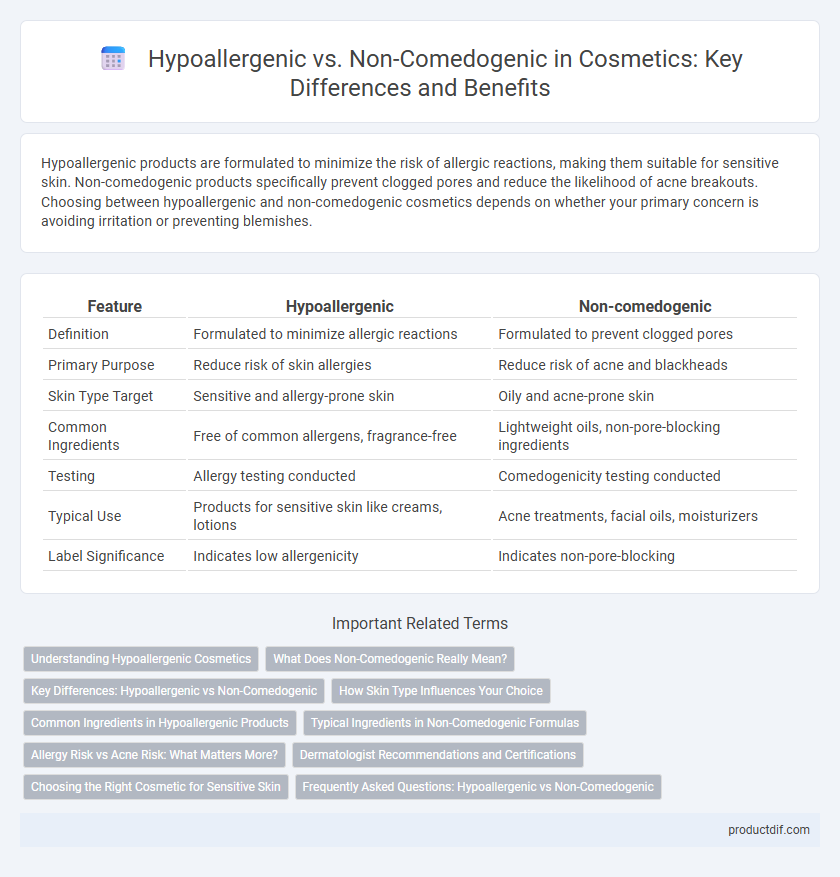Hypoallergenic products are formulated to minimize the risk of allergic reactions, making them suitable for sensitive skin. Non-comedogenic products specifically prevent clogged pores and reduce the likelihood of acne breakouts. Choosing between hypoallergenic and non-comedogenic cosmetics depends on whether your primary concern is avoiding irritation or preventing blemishes.
Table of Comparison
| Feature | Hypoallergenic | Non-comedogenic |
|---|---|---|
| Definition | Formulated to minimize allergic reactions | Formulated to prevent clogged pores |
| Primary Purpose | Reduce risk of skin allergies | Reduce risk of acne and blackheads |
| Skin Type Target | Sensitive and allergy-prone skin | Oily and acne-prone skin |
| Common Ingredients | Free of common allergens, fragrance-free | Lightweight oils, non-pore-blocking ingredients |
| Testing | Allergy testing conducted | Comedogenicity testing conducted |
| Typical Use | Products for sensitive skin like creams, lotions | Acne treatments, facial oils, moisturizers |
| Label Significance | Indicates low allergenicity | Indicates non-pore-blocking |
Understanding Hypoallergenic Cosmetics
Hypoallergenic cosmetics are formulated to minimize the risk of allergic reactions by avoiding common allergens such as fragrances, dyes, and harsh preservatives. These products are ideal for sensitive skin types prone to irritation but do not specifically address pore clogging or acne formation. Understanding the distinction between hypoallergenic and non-comedogenic products helps consumers choose cosmetics tailored to their skin's unique sensitivities and skincare goals.
What Does Non-Comedogenic Really Mean?
Non-comedogenic refers to skincare or cosmetic products specifically formulated to avoid clogging pores, thereby reducing the risk of acne and breakouts. Unlike hypoallergenic products that focus on minimizing allergic reactions, non-comedogenic products contain ingredients that do not contribute to the formation of comedones, such as blackheads or whiteheads. Choosing non-comedogenic cosmetics is especially important for individuals with acne-prone or oily skin seeking to maintain clear, healthy skin without irritation.
Key Differences: Hypoallergenic vs Non-Comedogenic
Hypoallergenic cosmetics are formulated to minimize the risk of allergic reactions by excluding common irritants, making them suitable for sensitive skin types. Non-comedogenic products are designed specifically to prevent pore clogging and reduce the likelihood of acne, targeting oil-prone and acne-sensitive skin. Understanding these distinctions helps consumers choose products tailored to their skin concerns, whether avoiding allergies or controlling breakouts.
How Skin Type Influences Your Choice
Hypoallergenic cosmetics minimize the risk of allergic reactions, making them ideal for sensitive skin prone to irritation. Non-comedogenic products are formulated to prevent pore clogging, crucial for individuals with oily or acne-prone skin. Choosing between these depends on whether your primary concern is sensitivity or acne, guiding you to safer, more effective skincare.
Common Ingredients in Hypoallergenic Products
Hypoallergenic cosmetic products commonly contain ingredients such as glycerin, aloe vera, chamomile extract, and allantoin, which are known for their soothing and anti-irritant properties that reduce the risk of allergic reactions. These formulations typically avoid fragrances, parabens, and dyes that can trigger sensitivities. Unlike non-comedogenic products, hypoallergenic items prioritize minimizing allergenic potential rather than solely preventing pore clogging.
Typical Ingredients in Non-Comedogenic Formulas
Non-comedogenic formulas typically contain ingredients such as salicylic acid, niacinamide, and zinc oxide, which help prevent clogged pores and reduce acne formation. These products often avoid heavy oils like coconut oil and cocoa butter, common in many hypoallergenic formulas, to minimize pore blockage. Common non-comedogenic ingredients also include glycerin and hyaluronic acid, which provide hydration without contributing to comedones.
Allergy Risk vs Acne Risk: What Matters More?
Hypoallergenic cosmetics are formulated to minimize allergy risk by using ingredients less likely to cause skin reactions, making them ideal for sensitive skin prone to irritation. Non-comedogenic products focus on preventing pore clogging, which helps reduce the risk of acne breakouts, especially for oily or acne-prone skin types. Choosing between hypoallergenic and non-comedogenic depends on whether the primary concern is allergic sensitivity or acne prevention, as each targets different skin health issues.
Dermatologist Recommendations and Certifications
Dermatologists often recommend hypoallergenic cosmetics for sensitive skin to minimize allergic reactions, supported by certifications from organizations like the National Eczema Association. Non-comedogenic products, certified by entities such as the American Academy of Dermatology, are specifically formulated to prevent pore clogging and reduce acne breakouts. Both certifications and dermatologist endorsements provide reliable guidance for choosing safe and effective skincare tailored to individual skin needs.
Choosing the Right Cosmetic for Sensitive Skin
Hypoallergenic cosmetics are specifically formulated to minimize the risk of allergic reactions, making them ideal for sensitive skin types prone to irritation or redness. Non-comedogenic products prevent pore clogging and reduce the likelihood of acne breakouts, which is crucial for individuals with sensitive, acne-prone skin. Selecting skincare and makeup labeled both hypoallergenic and non-comedogenic ensures gentle care while maintaining clear, healthy skin.
Frequently Asked Questions: Hypoallergenic vs Non-Comedogenic
Hypoallergenic skincare products are designed to minimize the risk of allergic reactions by excluding common irritants, making them suitable for sensitive skin. Non-comedogenic products specifically prevent clogged pores, thereby reducing the likelihood of acne and breakouts. Consumers often ask whether hypoallergenic means non-comedogenic, but these terms address different concerns: hypoallergenic targets allergies, while non-comedogenic focuses on pore blockage and acne prevention.
Hypoallergenic vs Non-comedogenic Infographic

 productdif.com
productdif.com